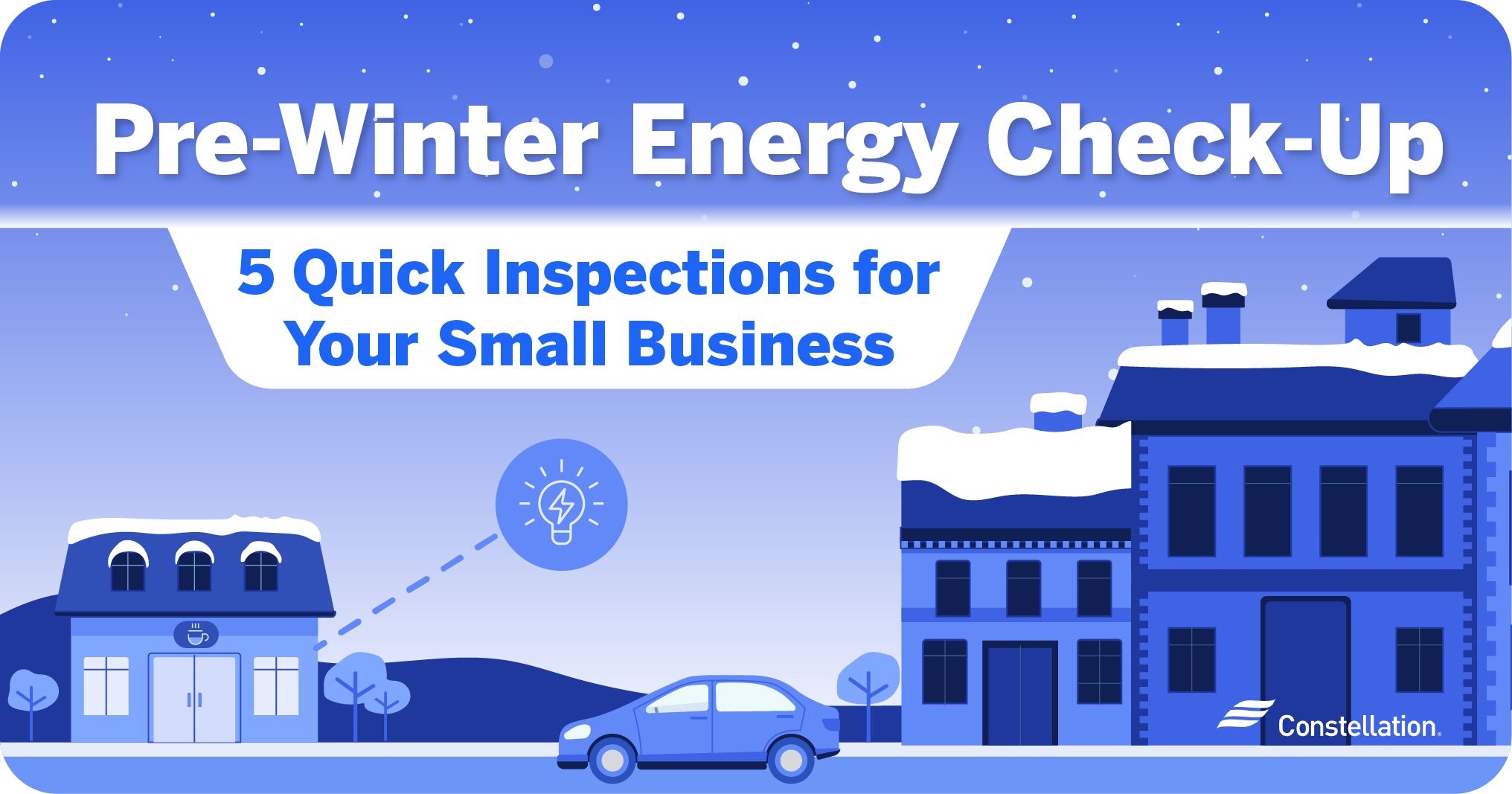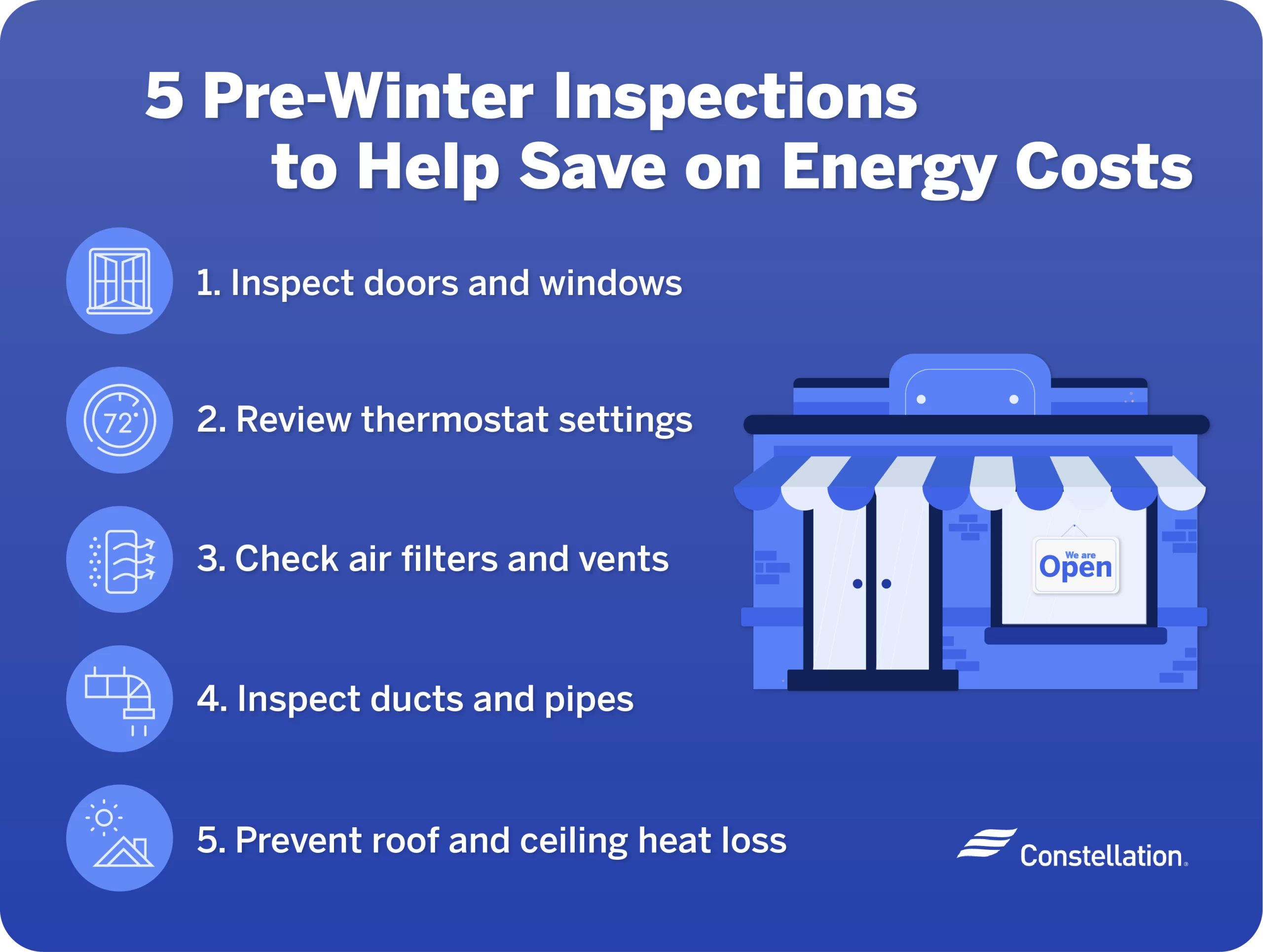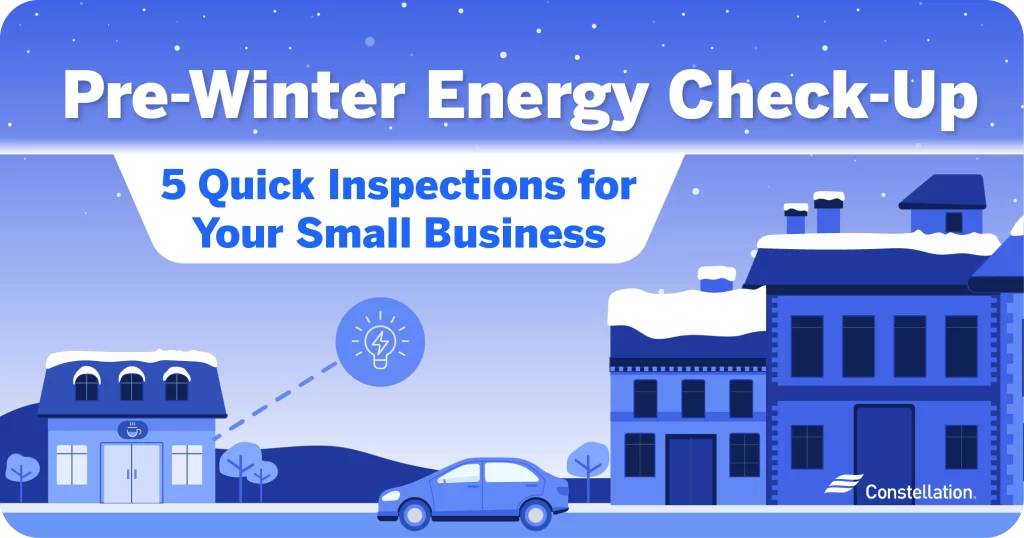
- Category:
Small Business Energy Savings -
Last updated:
October 27, 2025
Pre-Winter Energy Check-Up: 5 Quick Inspections for Your Small Business
Small business pre-winter inspections will help you get through the winter months cost-effectively and in comfort. What may seem like minor issues, such as air leaks, lack of insulation, and dirty, old HVAC filters, can quickly drive up your heating expenses. Neglecting to take care of your systems can increase the risk of a costly repair bill.
Take some time now to look for the most common cold-weather energy trouble spots. Here are five quick checks for pinpointing issues before temperatures drop. If you find any problems, you can take practical steps to fix them before winter hits.
5 easy winter inspections to help save on energy costs
These small business pre-winter check-ups help uncover problems that are easy to spot and may be quick to fix. Start by making a walk-through of your space with these five trouble spots in mind. You’ll be able to identify where you’re wasting energy and money, and where you might be risking a system breakdown.
Beyond identifying problems, we provide tips for winterizing your business with easy fixes that don’t require much skill, money or time. Here are five key small business pre-winter inspections to perform every fall.

1. Inspect doors and windows
Energy saving potential: You could save 10-20% on energy by sealing air leaks.
Doors and windows are well-known culprits for winter heat loss. Look for drafts around windows. Visible gaps, cracked seals and worn weatherstripping allow warm air to escape and cold air to seep in. An easy way to test for drafts is to hold a candle near the edges of windows. If the flame flickers, there’s likely a leak.
Caulk around window frames and weatherstripping to seal in the warm and take some of the burden off your heating system. Perform a similar inspection around doors. You can add weatherstripping around doors and add sweeps along their bottoms to reduce drafts.
2. Review thermostat settings
Energy saving potential: You could save as much as 10% a year by turning back your thermostat.
If you leave your thermostat at one setting all day, every day, you may be missing out on energy savings. Set a temperature schedule that matches your business hours and the times people are in your building.
Lowering the temperature even just a few degrees during off-hours will give you noticeable energy savings this winter. Installing a programmable smart thermostat makes it easier to consistently adjust your settings, ensuring employees are comfortable at work while avoiding unnecessary heating costs when your business is closed.
3. Check air filters and vents
Energy saving potential: Clean filters are crucial for HVAC units to operate efficiently, with energy savings depending on the unit’s size and condition.
If your HVAC system isn’t running efficiently, you are wasting energy. As for tips for winterizing your business, this one is easy and pays off big. Check and change your air filters often. Dirty filters make your system work harder and use more energy to move warm air into your building. Changing filters regularly is easy and inexpensive. It is one of the best ways to improve HVAC efficiency and to extend the life of your unit.
Check for blocked vents around your property. Move any furniture, boxes, or displays that are in front of vents to ensure that air moves freely. Clear, unobstructed vents help your system maintain an even temperature without working so hard.
4. Inspect ducts and pipes
Energy saving potential: Air duct cleaning could lead to 25-40% savings.
Add inspecting ductwork to your small business pre-winter check-ups. You can sometimes see peeling tape and visible gaps along the seams of your ducts. Turn your system on and listen for whistling sounds, which are a sign that air may be escaping the system. Repair even small leaks. They let warm air escape before it reaches the rooms where it is needed. Your systems will have to run longer and use more energy to make up for the loss.
Repairs may be simple to do yourself. Close leaks with UL-rated duct tape or use a mastic sealant. If your ducts run through unheated attics, basements or storage areas, wrap them in insulation to keep the air inside them warm. It also helps to clean your ducts annually so that air moves through them more smoothly.
5. Spot roof and ceiling heat loss
Energy saving potential: Preventing heat loss through the ceiling and roofs could save between 25%-35% on energy bills.
Since heat rises, it’s not surprising that roofs and ceilings are where you may be losing most of your warm air. Look for gaps, cracks, and areas with insufficient insulation. Use an infrared thermometer to check for problem spots. It’s more accurate than trying to judge where you’re losing hot air just by feeling it.
Close gaps and add new insulation where you find you have leaks, and add weatherstripping to vents and hatches. This will help keep the heat where it belongs while giving your HVAC system a break.
What to do next: Making a strategic plan for the winter
With these small business pre-winter inspections in mind, consider making them an annual part of getting ready for winter. Set a specific calendar date to do your inspections. Designating a special day for this important business task formalizes your efforts and ensures they’re completed every year. Doing all of your small business pre-winter check-ups, from checking doors and windows to insulation and your HVAC can pay off in energy budget savings and reduced maintenance and repair calls.
Take a look at your energy bill to see your energy usage and costs from last winter. Make the essential fixes suggested here and then see how your consumption this year compares to last. Most small business owners know how these simple changes lead to measurable reductions in energy usage.
While these basic small business pre-winter inspections are a great start, most businesses find value in adopting a more strategic and long-term plan. We invite you to use our winter preparedness guide with safety tips and comprehensive advice. It is invaluable in helping you develop your winter energy efficiency plan.




